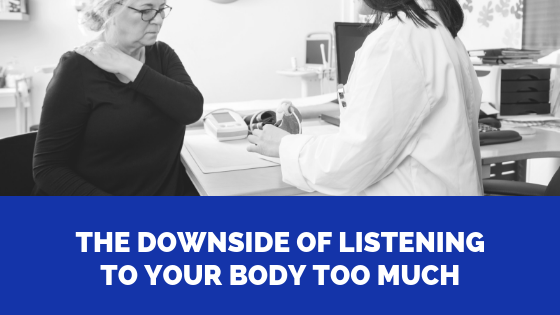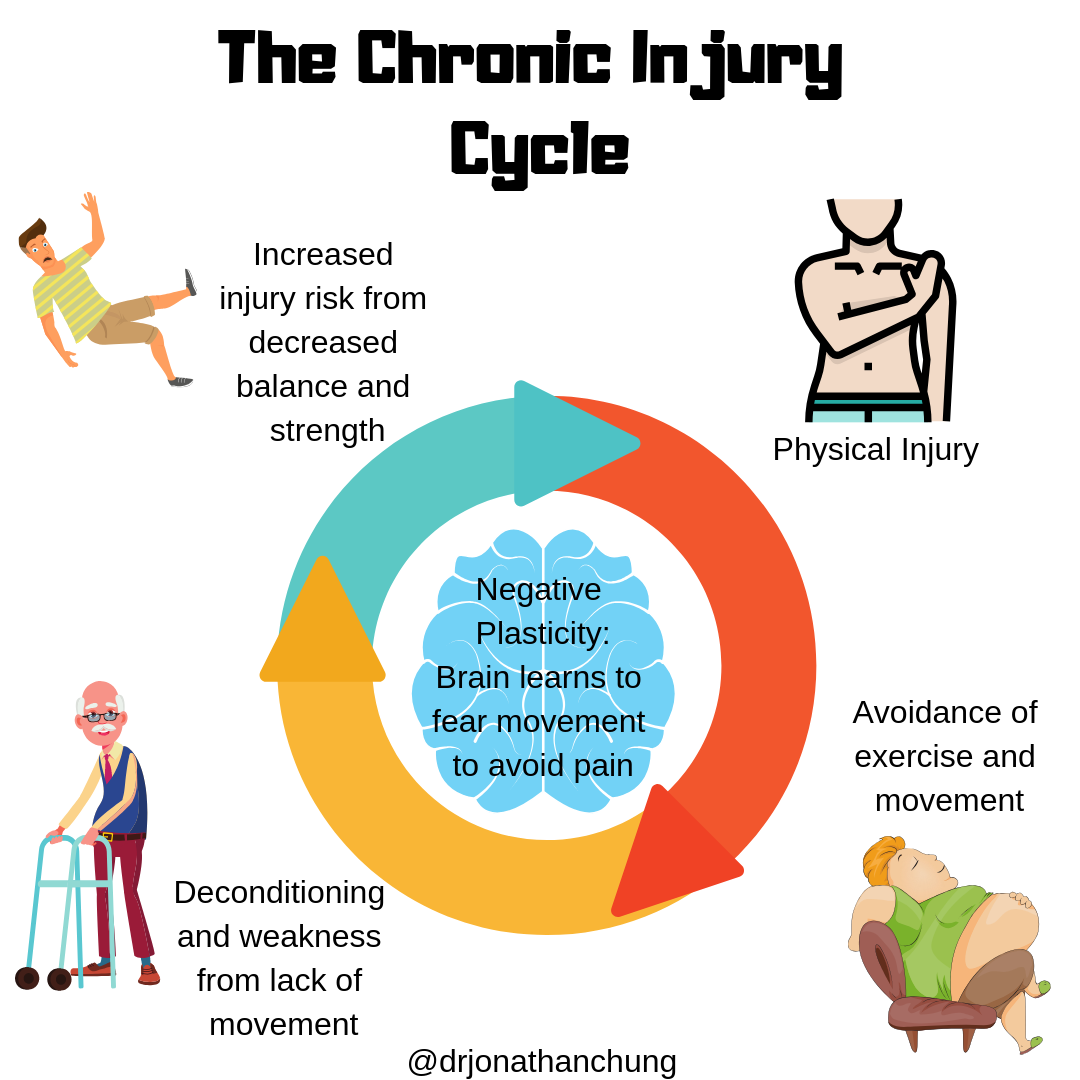By Dr. Jonathon Chung, Keystone Chiropractic
The Downside of Listening to Your Body Too Much
Historically I’ve been a big advocate of being “in-tune” with your body. For the most part, I do think that a generally healthy person can benefit from developing a better awareness of what their body is experiencing. It’s a good guide for adapting your training and developing a meditative practice like breath awareness.
In recent years, I’ve come to the conclusion that there are situations where a patient can be TOO in-tune with what their body feels, and this perception of what their body feels can actually create fear, apprehension, and further harm to their mental state and quality of life. Today we’ll discuss some of these types of situations and what a patient can do to help themselves break a negative connection with their own self-awareness.
When Listening to Your Body Goes Wrong
There’s a lot of research that shows that paying attention to inner body activities can be extremely beneficial for you. Things like being aware of your breath, meditation, counting your heart beat are all tools used in yoga and mindfulness practices that really help people a lot!
The concept of listening to your body has been popularized in the circles of fitness. It’s a phrase used to guide people in sport or exercise to recognize when their body may not be in the best state to complete a task.
It involves feeling out different aches or pains, observing where the body seems to be putting a restriction on movement, or just an inner awareness of fatigue. It’s supposed to be a guide against overtraining and possibly develop an awareness of impending injury. In cases where this is an otherwise healthy person with no history of chronic pain problems, it serves a good purpose.
However, in my experience seeing patients with chronic pain daily, a heightened attention and awareness of their own pain can be very counterproductive to a patient’s recovery and progression. Let’s talk about why.
Being In-Tune With Body Pain
It’s natural for your brain to pay attention to areas of your body that are in pain. It’s one of the ways your body protects itself whenever it has suffered an injury like a sprained ankle or a large cut on your hand. By avoiding contact of the injured body part, you are allowing your body to temporarily immobilize an area so that the natural healing responses can have time to fix the damaged tissue.
This is a necessary and completely normal response to physical injury. While this is a big generalization, the healing time for various tissues is shown in the graphic below. You can see that most minor muscle and ligament injuries can take a few days to heal while moderate to severe injuries can take several months.

So even in a worst-case scenario where you have an unstable injury that needs surgery, it takes about 2 years for a tissue to heal completely. If we know that these are the general healing times for people, then what explains the pain patients can feel for several years?
However, for some people there can be problems that develop in neurological pathways that perceive pain. What seemed like a simple, straight forward injury leads to chronic or persistent pain that lasts long beyond the normally allotted time for tissues to heal.
The problem in these cases is that many of these patients will avoid movements or activities to protect an area of injury that may not need protection and avoidance. So there ends up being a cycle of injury, stopping exercise, followed by deconditioning from lack of exercise leading to more risk of injury and pain.

The brain can learn to fear movement to avoid pain creating a vicious cycle often seen in persistent pain patients.
This is the result of treating the pain issue as a muscle or joint problem, when it’s really a brain and neurologically rooted problem. The kicker is that while avoiding movement is necessary for true joint injuries, avoidance may actually make a persistent pain problem in the brain even worse.
Many times when someone suffers with persistent pain issues that have no diagnosable injury, being too aware of your body’s painful triggers can be detrimental to healing and recovery.
Pain Science
One of the more popular concepts in pain science is the idea that chronic pain can develop from factors known as hypervigilance, catastrophizing, and fear-avoidance.
- Pain Hypervigelance – “when there is an excessive tendency to focus on pain or somatic sensation, or an excessive readiness to select pain-related information over other information from the environment.” [1]
- Catastrophizing – “an concept where people show exaggerated thoughts and descriptions of the negative consequences of pain featuring magnification, rumination, and helplessness” [2]
- Fear-Avoidance – a model of chronic pain that describes how people develop and maintain chronic pain as a result of attention processes and avoidant behavior based on pain-related fear. [3]
Those are nice academic definitions, but what do they mean for us? A lot of it comes down to being really fixated on how bad the pain is and avoiding anything that might be associated with the pain. And we now know that the fixation and avoidance behavior can reinforce maladaptive patterns in the way the brain is working.
So it is to say that being too focused on your pain when you are trying to heal can reinforce the cycle of staying in chronic pain.
Fostering an Anti-Fragile Mindset
One of the big things that drew me to chiropractic was a philosophical idea that the body is strong and has a remarkable ability to heal itself. It’s a mindset that I’ve had growing up while playing sports where my coaches would see someone get injured and they’d always say to just walk it off.
Obviously it’s not something you want to do with an unstable or serious injury like major sprains or a concussion. However, for things like scraping our shins, getting hit by a pitch in the back, pulling a muscle, or having a mild ankle sprain this approach trained our young minds to:
- Understand that the pain will go away on it’s own in time
- That our body and mind is strong enough to will away pain
- That we aren’t fragile
Ultimately, we came away with the mental state that we will feel better and pain goes away with time. This also meant that we were pushed towards our normal activities as quickly as possible.
As a chiropractor, a big part of my job is to foster a sense of strength and resiliency in my patients. It means that I want my patients to foster a sense of independence from their pain. That means I don’t want my patients to fear doing activities or to be dependent on any intervention whether that’s a drug, massage, or even chiropractic adjustment. I want my patients to never need me, but they can certainly count on me to be there when they want to be better.
Nuance
So before anyone takes my points to the extremes, let me just say this.
- Mental state won’t cure every pain
- Don’t avoid doctors, especially with serious injury/illness
- Many people will still have chronic pain even without a sense of fear avoidance and catastrophizing.
So with that out of the way. Mental state can be a powerful influence on the development and resolution of pain, but it can be really, really difficult. When we know there no longer a risk of worsening an injury, in order for patients to make the next step in their recovery, we have to engage them in doing the normal activities that they have avoided.
That might mean lifting some moderately heavy objects, bending their back forward, turning their heads, or getting back into exercise. Yes, sometimes that means we have to make patients revisit their pain and forcing their brain and nervous system to adapt and stop fearing it.
It means they have to stop listening to their body for a bit, and actually push through the false alarm signal so they can adapt.
It’s not easy, and it doesn’t happen quickly. But when patients are able to get there, the whole world opens up again, and we can start to pop the bubble that they’ve lived in because their brain is free again.

